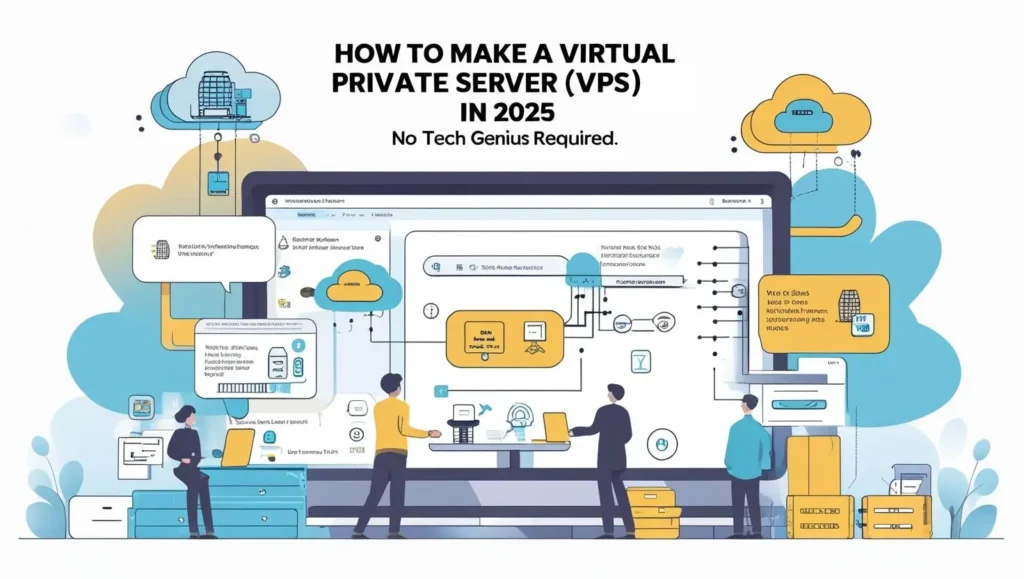Why Learn How to Make a Virtual Private Server in 2025? Whether you’re launching a website, hosting game servers, running applications, or just want complete control over your digital environment, a Virtual Private Server (VPS) is the way to go. But here’s the good news: you don’t need to be a server expert or sysadmin to set one up.
In this article, we’ll show you how to make a virtual private server (VPS) from scratch—even if you’re new to hosting—using the most reliable tools available in 2025.
What Is a Virtual Private Server (VPS)?
A VPS is a virtual machine hosted on a physical server. It acts like your own personal server environment—with dedicated resources, full control, and flexibility—without the cost of a full physical server.
You can install apps, run websites, configure firewalls, or even use it as a secure environment for development.
Benefits of VPS:
-
Full root access (control every aspect)
-
Faster than shared hosting
-
Scalable resources (CPU, RAM, disk space)
-
Reliable uptime and security
Step-by-Step: How to Make a Virtual Private Server (VPS)
tep 1: Choose a VPS Hosting Provider
Some trusted providers for 2025 include:
At Wix Infotech, we also help clients set up secure VPS environments as part of our custom hosting and development packages.
Most providers offer beginner-friendly plans starting at $5–$10/month.
Step 2: Select Your Server Specs
Choose:
-
OS (Ubuntu 22.04 LTS is a solid beginner-friendly Linux distro)
-
RAM (1GB+ for small websites or testing)
-
CPU (1-2 vCPUs minimum)
-
Storage (SSD for faster performance, min 25GB)
-
Location (Pick a region near your target audience for speed)
Step 3: Deploy and Access Your VPS
Once your plan is selected:
-
Click “Create Droplet” or similar
-
Choose password or SSH key authentication
-
Wait for provisioning (usually <1 minute)
After setup, you’ll receive:
-
IP Address
-
Root password or SSH login credentials
Use an SSH client like PuTTY or Terminal (Mac/Linux):
ssh root@your-ip-address
Step 4: Secure Your VPS
Before doing anything else:
-
Change the root password
-
Create a new user with limited privileges:
adduser yourusername
Enable a firewall (like UFW on Ubuntu):
ufw allow OpenSSH
ufw enable
Step 5: Install a Web Server (Optional)
If your VPS will host a website, install a web stack like:
-
LAMP (Linux, Apache, MySQL, PHP)
-
LEMP (Linux, NGINX, MySQL, PHP)
Example:
apt update && apt install apache2 mysql-server php libapache2-mod-php
You now have a basic VPS that can host WordPress, apps, or any custom project.
Common Uses of a VPS in 2025
-
Host websites (WordPress, eCommerce, custom apps)
-
Deploy Node.js or Python servers
-
Create a private game server
-
Run email servers
-
Use as a VPN for privacy
-
Develop or test code in isolation
FAQs: VPS for Beginners
Is a VPS better than shared hosting?
Yes, it’s more powerful and private, giving you better control and performance.
Can I set up a VPS without coding knowledge?
Yes. Many platforms offer one-click installs. Or, companies like Wix Infotech can help you set everything up.
How much does it cost to make a VPS?
You can start for as low as $5/month. Managed VPS plans cost more but save you time.
Conclusion: Build Smarter, Not Harder
Learning how to make a virtual private server gives you the tools to build faster websites, secure your digital presence, and have complete control—all at an affordable cost.
Whether you’re a business owner, web developer, or startup founder, a VPS is a smart investment in 2025.
📞 Need help setting up your VPS?
Visit Wix Infotech’s Services or Contact Us for professional VPS setup, maintenance, and support—all tailored to your needs.

